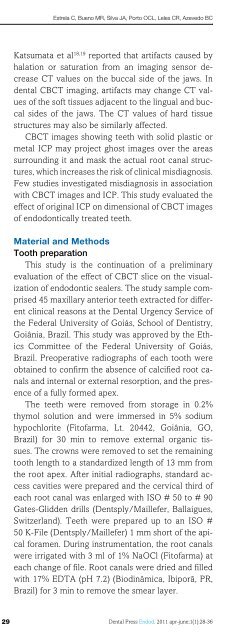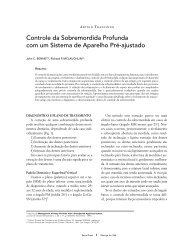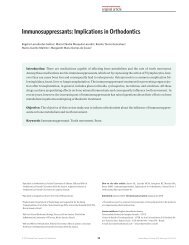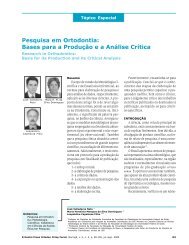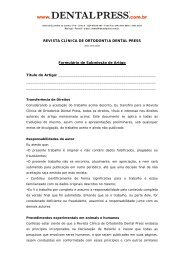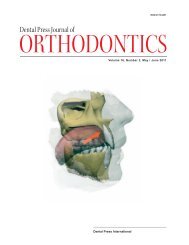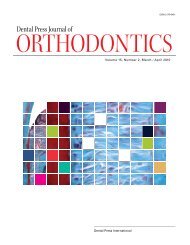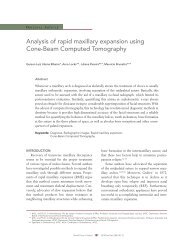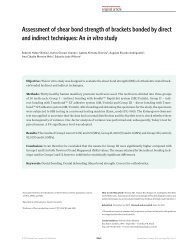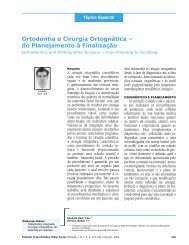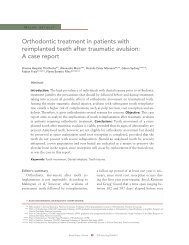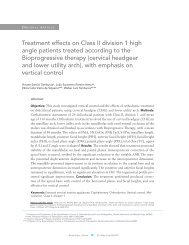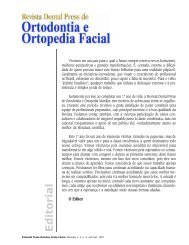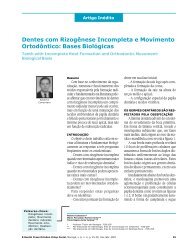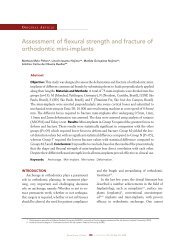Dental Press
Dental Press
Dental Press
You also want an ePaper? Increase the reach of your titles
YUMPU automatically turns print PDFs into web optimized ePapers that Google loves.
Deonízio MD, Sydney GB, Batista A, Estrela CIntroductionThe success of endodontic treatment is related todifferent factors like correct cleaning and shaping andsanitization of the root canals. 1 Biomechanical preparationusing instruments and irrigating solutions offers away to combat the endodontic microbiota. In this way,intracanal dressing increases the power of the sanitizationprocess. 2,3Calcium hydroxide is, currently, the most used intracanaldressing, due to its physical and chemical properties.It has a high pH, antibacterial activity, acts in thedegradation of bacterial lipopolysaccharides, induceshealing through the formation of hard tissue, and controlsradicular resorption. 3,4,5,6As ionic calcium hydroxide dissociation occurs, thepaste quantity to be placed within the root canal mustbe enough to supply hydroxyl and calcium ions overa period of time necessary for sanitization of the rootcanal system. 4,7,8,9 Its effectiveness is dependent on thedirect action between the paste and remaining microorganismsin the dentinal tubules. 10,11 To reach this goalthe root canal must be homogeneously and completelyfilled with the paste showing a tri-dimensionally densex-ray image. 6,8 Many times, ineffectively of calcium hydroxidecan be explained by the manner in witch it isplaced, ie, the canals are not filled in the middle andapical thirds. 9In general, its insertion is performed by using instrumentsand endodontic materials, such as K-files, reamers,absorbent paper points, gutta-percha cones, amalgamcarriers, McSpadden compactors, Lentulo spirals,ultrasonic and sonic files, ML syringe (SS White), and27G long needles. 3,4,5Cvek et al 12 proposed the use of an injection syringeor Lentulo spiral aided by lateral condensation. Webberet al 13 suggested the use of a plastic transporterto drive the paste into the root canal followed by aneffective vertical condensation. To Anthony and Senia14 the ideal way of calcium hydroxide filling is usingthe Lentulo spiral. Leonardo 15 recommended theuse of a special syringe with a long G-27 needle inthe Calen system. Sigurdsson et al 16 comparing theLentulo spiral, endodontic file and syringe, pointed tothe first, the best results accompanied by others authors.12,14 However, these findings have not been unanimous,and empty spaces have been identified in somestudies. 3,17,18 Estrela et al 3 analyzing the placement ofcalcium hydroxide in dog’s teeth obtained the lowestnumber of empty spaces when the paste was insertedusing a K-file, absorbent paper points and verticalpluggers, followed by the Lentulo spiral. Torres et al 19concluded that the radiodensity of the paste in curvedplastic resin block canals was significantly greater usinga Lentulo spiral only technique.But, there are two critical points with the Lentulo spiralfilling: the speed and the paste quantity inserted ateach time. Different speeds have not yet been studied.In the methodology used by Deveaux et al 18 the speedof 500 rpm was referred to. However, Rahde et al 20 andCaliskan et al 21 only refer to low and moderate speeds,without specifying it.The aim of this study was to verify the efficacy ofcalcium hydroxide filling with the Lentulo spiral at differentspeeds.Material and MethodsThirty lower premolars from the tooth bank of theFederal University of Paraná Dentistry School — byauthorization of the Research Ethics Committee ofthe Health Sciences Sector – CEP/SD registrationnumber 584.121.08.07; CAAE research protocol:2407.0.000.091-08 — were selected for this study.The teeth were classified by an average length of 20mm and the presence of a single root canal, confirmedthrough a mesiodistal and buccolingual radiography.The crown was maintained in order to reproduce theclinical conditions.Access was performed using a spherical diamondtippedhigh-speed drill nº. 1014 (KG Sorensen) andcompleted with nº 3205 (KG Sorensen). The workinglength was determined 1 mm from the anatomic apex,maintaining patency with a #10 K-fileRoot canal preparation was performed in a crowndowntechnique aided by a reciprocating angle TEP 4R-NSK. Teeth were instrumented to a # 50 master apicalfile 1 mm from the anatomic apex. The canals were irrigatedwith 1% sodium hypochlorite followed by 17%EDTA-T witch was left in place for 3 minutes to removesmear layer, followed by a final flush with sodium hypochlorite.The foramen was coated with a small piece ofwax to prevent calcium hydroxide extrusion.The specimens were randomly divided into 3 experimentalgroups. Calcium hydroxide paste wasprepared for each tooth by mixing 1 g of calcium© 2011 <strong>Dental</strong> <strong>Press</strong> Endodontics 59<strong>Dental</strong> <strong>Press</strong> Endod. 2011 apr-june;1(1):58-63


